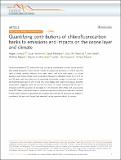Quantifying contributions of chlorofluorocarbon banks to emissions and impacts on the ozone layer and climate
Author(s)
Lickley, Megan Jeramaz; Solomon, Susan; Fletcher, Sarah Marie; Stone, Kane Adam
DownloadPublished version (1.461Mb)
Publisher with Creative Commons License
Publisher with Creative Commons License
Creative Commons Attribution
Terms of use
Metadata
Show full item recordAbstract
Chlorofluorocarbon (CFC) banks from uses such as air conditioners or foams can be emitted after global production stops. Recent reports of unexpected emissions of CFC-11 raise the need to better quantify releases from these banks, and associated impacts on ozone depletion and climate change. Here we develop a Bayesian probabilistic model for CFC-11, 12, and 113 banks and their emissions, incorporating the broadest range of constraints to date. We find that bank sizes of CFC-11 and CFC-12 are larger than recent international scientific assessments suggested, and can account for much of current estimated CFC-11 and 12 emissions (with the exception of increased CFC-11 emissions after 2012). Left unrecovered, these CFC banks could delay Antarctic ozone hole recovery by about six years and contribute 9 billion metric tonnes of equivalent CO2 emission. Derived CFC-113 emissions are subject to uncertainty, but are much larger than expected, raising questions about its sources. ©2020
Date issued
2020-03Department
Massachusetts Institute of Technology. Department of Earth, Atmospheric, and Planetary Sciences; Massachusetts Institute of Technology. Department of Civil and Environmental EngineeringJournal
Nature communications
Publisher
Springer Science and Business Media LLC
Citation
Lickley, Megan, et al., "Quantifying contributions of chlorofluorocarbon banks to emissions and impacts on the ozone layer and climate." Nature communications 11, 1 (March 2020): no. 1380 doi 10.1038/s41467-020-15162-7 ©2020 Author(s)
Version: Final published version
ISSN
2041-1723